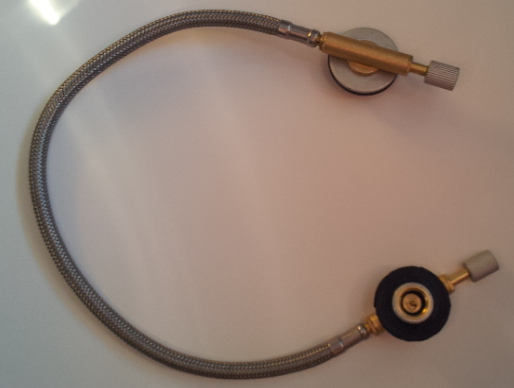Making your own blend of propane/butane winter fuel mix: (The Steps we use).
First off, you must note the normal caveats:
- Do Not Do this yourself
- It may break laws in your jurisdiction
- It could be dangerous
- Manufacturers of camping stove canisters say they are single use only
- This only describes the way we do this, it is not the only way, and there may be better ways.
- We research and use all the appropriate safety procedures for working with compressed flammable gas when we undertake an hobby projects of this nature. We then:
- Do some math to determine how much propane, and how much butane you are going to need to infuse into your slave canister. For example, the smallest canisters typically hold a net of 110g of liquid fuel. If you are going for a 30/70 winter mix, you will be transferring 33g of propane and 77g of butane.
- Be sure the canister is empty by weighing first. An empty canister is the 'tare' weight. For example, the average tare of an empty small butane canister is 100g. (The main reason this is important is to ensure you are going to get the correct ratio of propane/butane when you refill). Place the empty receiving canister outside when it is -20C. If it is summer, you may have to go to Quttinirpaaq to do this. (Some place it in their freezer. Just be aware if the canister leaks in the freezer and there is a light that comes on when the door opens, it may go boom. It does seem unlikely that an empty canister will purge itself of any residual vapour when it is being frozen however.)
- Place the donor canisters somewhere where they will get warm. Use you imagination: a nice warm beach in SE Asia is a good spot for example. (The impecunious amongst us may use a warm water bath, the daring may use forced hot air and an IR Gun Thermometer and bare hand as a sensor. As noted above, our way is not the only way, and there may be better ways).
- While wearing safety gear such as eye protection and gloves, do all the following outside, in a well ventilated area, with no open flames nearby.
- Start with propane because if you overfill, you can purge and adjust your net weight to achieve your target of 30% before adding butane. Connect your propane donor bottle, and your butane slave bottle with the refill line, making sure both valves are in the closed position, and being aware that a small amount of gas may purge when you are doing this withal.
- Place the butane bottle on an analog weigh scale (digital scales tend to 'time out' before the process is complete, making it hard to determine your net weight) in an upright position, and fasten or have an assistant hold the propane bottle in an inverted position above the butane bottle.
- Zero out the scale so it will just reflect your 'net' weight of fuel feeding into the slave canister.
- When canisters are in 'optimum positional relativity' (as described above), (we use a bike tune up stand BTW to secure the upper inverted canister - because we have no friends and therefore cannot find an assistant), open the valve on the upper canister first, then the lower canister valve.
- Watch the scale, and shut the valves off in reverse order to above sequence when the net target weight of propane is achieved (in the case of the smallest canister, 33g). If you cannot achieve that amount, you may have to rechill, and rewarm, the respective canisters and repeat the process. If you overfill, purge the slave canister to correct the net weight.
- Rechill the slave canister. Then connect a donor butane canister (this could be another of the campstove canisters such as the MSR or Primus, etc. that has some leftover butane in it, or one of the Asian Market canisters that will require an additional adapter to connect to the butane refill line).
- Again, following steps 4 through 9 above but substituting the word 'butane' for 'propane', fill the slave butane canister with your target weight of butane (in the case of the smallest one, this would be 77g).
- Remove your refill lines, weigh the canister for its gross weight to confirm that the sum of gross-tare does not equal more than the rated net for your particular canister. For example, in the case of the small MSR canisters, the net is 110g, and the gross should not exceed 211g.
- If you have exceeded the gross weight of your canister, you can purge it where safe to do so. Purge methods could also include using a Primus, Brunton, or Soto fill adapter to use the extra fuel to refill your lighters.
- Check the Lindal valve for leaks, then store your canister in an ventilated, unheated location that is not a dwelling place. Store there until you are ready to deploy it in the field in support of your aeropress.
- Here is a repeat of the same video from the previous page showing this process:



